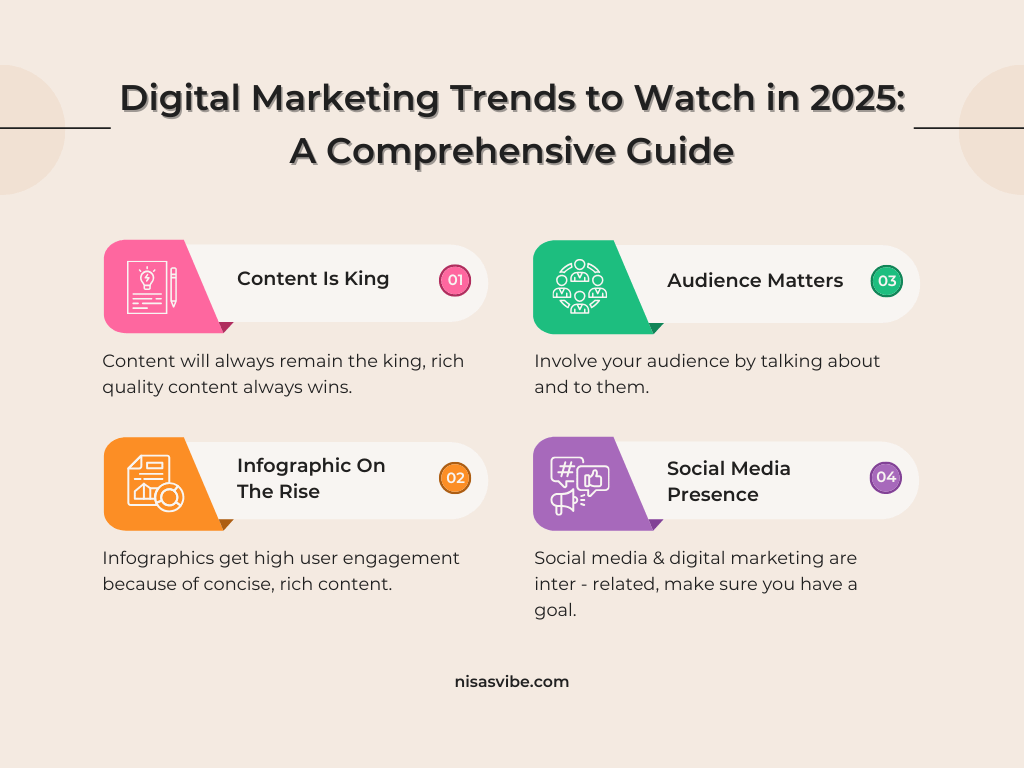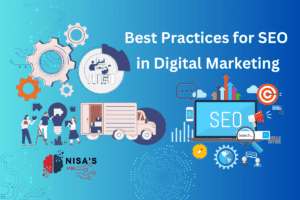Hi, I’m Nisa! As we move deeper into 2025, digital marketing continues to evolve, bringing new opportunities and challenges for businesses. Staying ahead of the curve is crucial to remain competitive, and understanding the emerging digital marketing trends can give your business the edge it needs. In this comprehensive guide, we’ll explore the most significant digital marketing trends to watch in 2025, and how they can help you grow your business and connect with customers more effectively.
1. AI and Machine Learning: The Future of Personalization
Artificial Intelligence (AI) and machine learning are no longer just buzzwords—they are shaping the future of digital marketing. In 2025, AI will become even more integrated into marketing strategies, allowing businesses to deliver hyper-personalized experiences at scale.
Why it matters:
- AI-driven personalization helps businesses deliver tailored content and offers based on customer behavior, increasing engagement and conversions.
- Chatbots and virtual assistants powered by AI will enhance customer service, providing quick and accurate responses to customer queries.
- AI can predict customer behavior and help businesses create targeted campaigns with minimal manual effort.
How to leverage AI:
- Use AI-powered tools: Implement tools like ChatGPT, HubSpot, or Salesforce to automate tasks and deliver personalized customer experiences.
- Optimize for customer journey mapping: AI can analyze customer data to create targeted content and predict the next steps in the customer journey.
- Chatbots: Integrate chatbots into your website or social media platforms to provide instant responses and increase engagement.
2. Video Marketing Continues to Dominate
In 2025, video marketing will continue to dominate as one of the most effective content formats. With the rise of short-form videos on platforms like TikTok, Instagram Reels, and YouTube Shorts, video has become the go-to medium for businesses to engage with their audience.
Why it matters:
- Video content increases engagement and brand recall, as it is more likely to be shared and remembered by viewers.
- Live streaming is gaining traction, with businesses using platforms like Facebook Live and Instagram Live to interact with their audience in real-time.
- Video ads are one of the most effective ways to drive conversions, especially on social media platforms.
How to leverage video marketing:
- Create short-form videos: Focus on creating bite-sized, engaging videos that capture attention quickly. Share behind-the-scenes content, product demos, or customer success stories.
- Live streaming: Host live events, Q&A sessions, or product launches to connect with your audience in real time.
- Video ads: Invest in video ads on platforms like Facebook, Instagram, and YouTube to increase reach and engagement.
3. Voice Search Optimization: Preparing for the Future
Voice search is becoming an integral part of how consumers interact with the internet. With the growing use of smart speakers like Amazon Alexa and Google Assistant, voice search is changing the way users search for products and services online.
Why it matters:
- Voice search is expected to account for a larger share of search queries, making it essential for businesses to optimize their content for voice search.
- Voice search queries are typically longer and more conversational, which means businesses need to adapt their content strategy to match this shift.
- Local SEO will become even more important as voice search is frequently used to find businesses, restaurants, and services nearby.
How to leverage voice search optimization:
- Use natural language: Focus on conversational keywords and phrases that users might speak rather than type.
- Optimize for local search: Ensure your business is optimized for local SEO and appears in voice search results for location-based queries.
- Schema markup: Implement structured data on your website to provide search engines with detailed information about your business, making it easier for voice assistants to pull up relevant information.
4. Social Commerce: Shopping Directly on Social Platforms
Social commerce is on the rise, and by 2025, it will become a mainstream way for businesses to sell products directly through social media platforms. Instagram Shops, Facebook Marketplace, and Pinterest Shopping are just a few examples of how social commerce is changing the way consumers shop online.
Why it matters:
- Social media platforms already have a massive audience, and integrating shopping directly into these platforms allows businesses to reach customers where they spend the most time.
- Social commerce provides a seamless shopping experience, making it easier for customers to discover and purchase products without leaving the app.
- Influencer marketing will play a key role in driving sales through social commerce, with influencers promoting products directly on social platforms.
How to leverage social commerce:
- Set up a shop on Instagram and Facebook: Create a seamless shopping experience by tagging products in your posts and stories.
- Use influencer partnerships: Collaborate with influencers to promote your products directly on their social media accounts.
- Make the checkout process easy: Ensure that your social commerce experience is user-friendly and allows customers to complete their purchase with minimal friction.
5. Augmented Reality (AR) for Enhanced Shopping Experiences
Augmented Reality (AR) is revolutionizing the way consumers shop by allowing them to virtually try on products or visualize items in their environment before purchasing. In 2025, AR will continue to grow as a powerful tool for enhancing customer experiences.
Why it matters:
- AR provides an interactive and immersive shopping experience that can help businesses stand out from competitors.
- It increases the likelihood of conversions by giving customers a better sense of how products will look or fit in real life.
- Brands in industries like fashion, furniture, and beauty are already seeing the benefits of AR in driving sales and improving customer satisfaction.
How to leverage AR:
- Virtual try-ons: Offer virtual try-ons for clothing, makeup, or accessories to help customers visualize how products will look on them.
- Product visualization: Use AR to allow customers to place furniture or home decor items in their homes to see how they fit within their space.
- AR filters: Create fun, branded AR filters on platforms like Instagram and Snapchat to engage your audience and increase brand awareness.
6. Privacy and Data Protection: A Growing Concern
As concerns around privacy and data protection continue to grow, businesses will need to adapt their digital marketing strategies to be more transparent and ethical in how they handle customer data. With the implementation of stricter regulations like the GDPR and CCPA, data privacy is becoming a key focus for both consumers and businesses.
Why it matters:
- Customers are increasingly concerned about how their data is being used and expect businesses to be transparent and secure with their personal information.
- Trust is a significant factor in purchasing decisions, and businesses that prioritize privacy will gain a competitive advantage.
- Failure to comply with privacy regulations can lead to hefty fines and damage to your brand’s reputation.
How to prioritize privacy and data protection:
- Be transparent: Clearly explain how customer data is collected, used, and stored in your privacy policy.
- Secure customer data: Invest in cybersecurity measures to protect your customer’s personal and payment information.
- Compliance: Ensure your business complies with GDPR, CCPA, and other relevant regulations.
7. Interactive Content: Engaging Your Audience
Interactive content, such as quizzes, polls, surveys, and interactive infographics, will become more popular in 2025 as brands look to engage customers in more meaningful ways. Interactive content encourages customers to actively participate rather than just passively consume information.
Why it matters:
- Interactive content increases engagement and time on site, both of which are important for improving SEO and conversions.
- It helps businesses collect valuable insights into customer preferences, behavior, and needs.
- Interactive content can enhance brand awareness and customer loyalty by making the experience fun and engaging.
How to leverage interactive content:
- Create quizzes and polls: Use interactive quizzes to help customers choose the right products or services for their needs.
- Host surveys: Collect feedback from your audience to improve your products, services, and customer experience.
- Interactive videos: Create videos that allow users to make choices or interact with the content to explore different outcomes.
Stay Ahead of the Curve in 2025
As we approach 2025, staying on top of digital marketing trends is essential for maintaining a competitive edge. From AI-powered personalization to social commerce and augmented reality, these trends will shape the way businesses interact with their customers. By embracing these trends and adapting your strategies, your business can thrive in an increasingly digital world.
Stay proactive, be flexible, and continuously innovate to ensure your marketing efforts are effective in the rapidly changing landscape of 2025.




